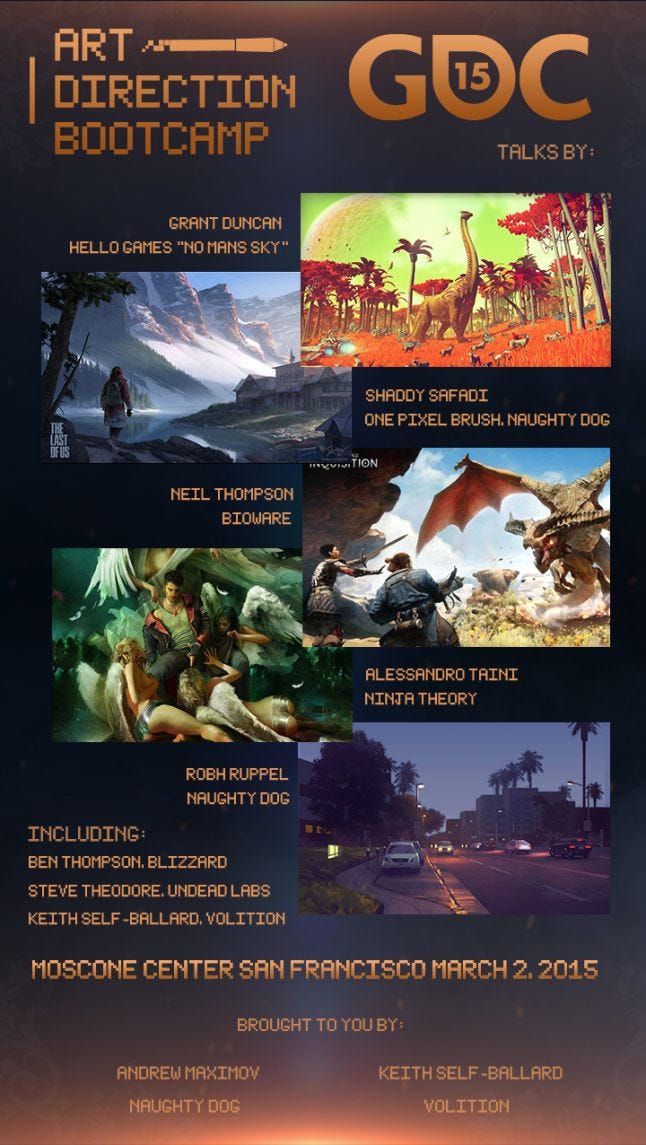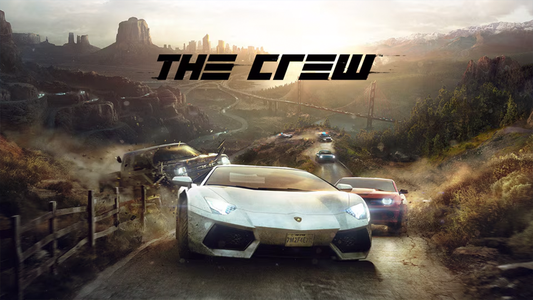Andrew Maximov is a senior artist at Naughty Dog.
Art direction is not just something art directors do. Art direction is in every brush stroke we lay down and in every vertex we move. It is the idea that you're trying to communicate and the emotion you put into it. It is the dialog that you're having with your audience, while the tools are just means for delivery.
If you care about art, we would be privileged to see you join us in San Francisco on March 2 for an entire day of deep and thought-provoking art discussion from the absolute best in the business, during GDC's Art Direction Bootcamp. If you're going to Game Developers Conference -- don't miss it!
In the meantime, I've gathered some of the most experienced and talented senior artists in the game industry to answer a few questions from Twitter, Polycount, and from one another:
Andrew Maximov, Senior Artist - Naughty Dog
Neil Thompson, Director of Art & Animation - BioWare
Grant Duncan, Art Director - Hello Games
Keith Self-Ballard, Principal Artist - Deep Silver Volition
Robh Ruppel, Art Director - Naughty Dog
Let's begin!
- Twitter user Kickpixel asked:
Is it better to develop story from concept or develop the concept art from the story?
Robh: It's better to work on both at the same time and let one inform the other.
Neil: We start with the main narrative beats and work from there. Writing can be utterly unconstrained in its initial form and isn't bound by any perceived technical parameters that could be imposed by prospective visuals… that comes later! As soon as the outline is there and the concept team is working, then it becomes an iterative back-and-forth process.
- Twitter user Gabe Gedarovich asked:
Are full-time concept artists widely used, or is that work done mostly "as needed"?
Neil: BioWare has a team of full-time concept artists who have grown with the franchises and understand them intimately. We do use contractors in addition; but the signature content of characters and key architectural pieces are handled by the internal team.
Robh: Personally having the team on site as staff yields better results. Better interaction, better communication, better rapport.
- Twitter user Bacioiu Ciprian asked
What's the state of organic model procedural generation in the industry right now? Is it, to your knowledge, worth looking into?
Grant: Procedural organic modelling is still very niche, but it's slowly starting to be used more and more. Like most new tech, it usually starts by being accessible to only a handful of very smart coders, often working in larger studios. They then create in-house tools, and these tools and techniques slowly spread into the mainstream for the rest of us normal folk to play with. We aren't quite there yet, but I fully expect to see more organic procedural tech creeping into tools like Maya, ZBrush, etc. The more developers playing with procedural technology, the better the tools will become, and the more fun we'll all have!
Andrew: It is definitely worth looking into but probably not as your main area of expertise. Procedural generation in general is fairly limited in mainstream games, but who says you can't be the person to turn it all around?
Right now most of "procedural" generation boils down to geometry shaders randomly placing foliage and props on terrain, and a few outstanding games like Spore, Minecraft and No Man's Sky. But if there's one thing we know for sure it's that it's only going to go up from here, and the moment someone finds a usecase that solves a problem or speeds up a process, that particular usecase will become ubiquitous and the whole thing will start getting traction way, way faster.

- Twitter user Ken Henderson asked:
What's the tougher task to manage: Junior team/contractors who need to be brought up to speed while on a deadline, or a "creative" executive who has some ideas about the project?
Neil: Great question…the second scenario is much tougher to manage! Often these situations arise because everyone has an opinion and often “executive” opinions carry added weight while being less informed of the technicalities of implementation.
Calm and reasoned discussion is the only forum to find a solution…
Andrew: I'd have to say a "creative" executive. For one, a junior can't really steer a project off course.
I do want to stress that despite the horror stories, most executives are competent and well-meaning professionals. But as with any profession, sometimes things can go a bit askew.
And the only thing you can do about it is keep the dialog going. You are hired to act based on your best professional sensibilities and argumentatively disagreeing is part of the job -- a very important one at that. People will routinely throw solutions at you when all they are really trying to do is solve a problem. So ask for their problems first. When everyone is on the same page about those it is way easier to find a solution.
Keith: Both situations are challenging, even if for different reasons. Rather than give you my impression of which is the "worse" scenario, which would provide little in the way of insight, I'd like to provide some guidelines on how to handle each one.
" Procedural generation in general is fairly limited in mainstream games, but who says you can't be the person to turn it all around?"
First, on dealing with junior team/contractors who need to be brought up to speed: This situation arises usually in the heat of production. The good news is that, if you have planned properly, you likely already have documented your art style and development pipeline. The bad news is that as production wears on, the likelihood of such documentation having grown antiquated increases.
In this situation, you will find yourself relying on experienced artists (perhaps even senior staff) directly reviewing and mentoring the new team members. This will be a hard fight, as producers will see this as a drain on your most talented staff. Stay the course. This is a textbook lesson in short-term pain for long term gain. No one is going to like it, and you should be prepared for the senior staff to fight it as the training wears on. Stay the course. Once some of the junior staff have proven themselves reliable (and you've taken the steps to weed out those who aren't going to make it), the improvement to the team should be noteworthy.
Now, for managing a "creative" executive who has some ideas: First of all, I want to reject the notion that executives are not "creative." Naturally, their creativi





































